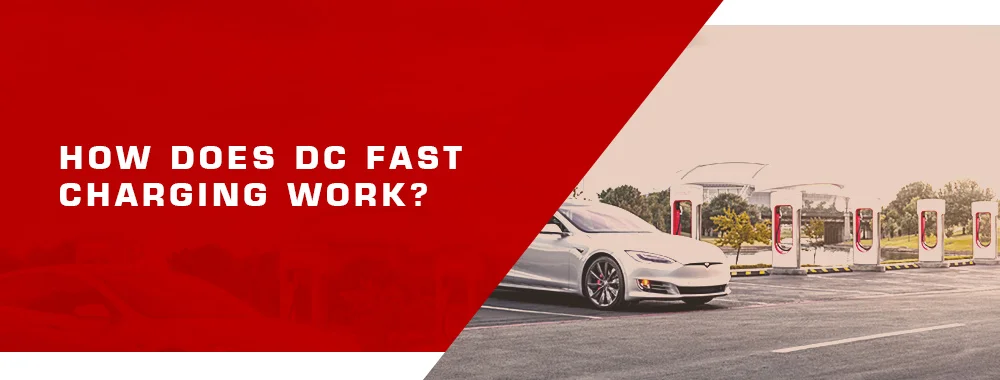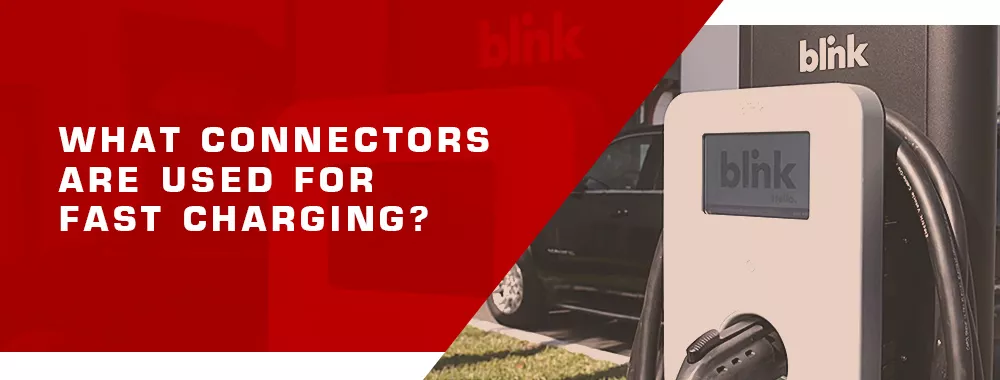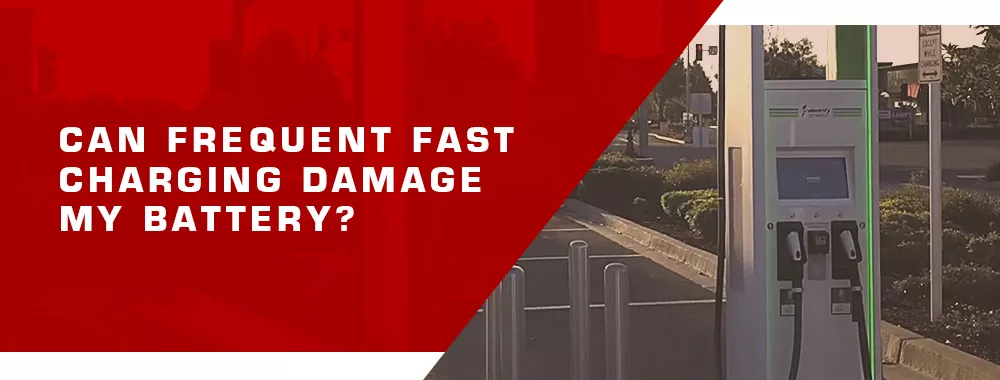Yes, DC charging can be detrimental under the special circumstances described in the experiment of this article. Importantly, batteries prefer to run at comfortable temperatures, usually in the 70–80 degree Fahrenheit range (approximately 20–25 degrees Celsius). Fast charging provides more power, which can produce heat that “loads” the batteries more than charging from AC power. Some cars also have air conditioning to provide the optimum temperature for charging. Although heat stress has minimal effect on battery life over time, it is still recommended to rely on Level 2 for everyday charging [13].
Is using a DC fast charging station really bad for an electric car battery?
Turns out, not as much as you might think. Read more about the experiment below. However, frequent use of fast constant current charging can have a negative effect on battery performance and longevity. But often there are recommendations to minimize the use of fast constant current charging.

Publicly available Level 3 DC fast charging stations can charge an electric car battery to 80 percent of its capacity in about 30–60 minutes. This depends on the vehicle and the air temperature (a cold battery charges more slowly than a warm one). Although most electric car charging is done at home, fast charging can also come in handy if the electric vehicle’s charge becomes too low, say, during a trip. Knowing the locations of Level 3 stations [22] is necessary for those going on long trips.
Availability of fast charging stations
Drive Electric Tennessee and TDEC are reportedly planning to increase the number of fast charging stations. The distance between stations is planned to be no more than 50 miles. This will help improve the availability of infrastructure in areas far from cities. It will also encourage more electric vehicles by 2028 to 200,000.

U.S. electric vehicles use the SAE combination connector also known as CCS1. Most models from Asian automakers use the so-called CHAdeMO connector. And many Level 3 charging stations support both types.
Tesla uses its own connector to access its high-speed Supercharger network, which is limited to its own vehicles. However, Tesla owners can use other publicly available chargers through the adapter that comes with the car.
What are the differences between DC and AC when charging an electric car?
While home chargers use alternating current that is converted to direct current by the car, the Level 3 charger supplies direct DC power. This allows you to charge your car faster. The fast charging station is in constant communication with the electric vehicle to which it is connected. It monitors the vehicle’s charge level and delivers exactly as much power as the vehicle can handle, which varies from model to model. The station regulates the flow of electricity appropriately so that it does not overload the vehicle’s charging system or damage the battery.
Statistics say that most drivers drive no more than 50 miles in a day. Therefore, many people use fewer fast chargers enough to meet their charging needs.
Does the electric car battery charge evenly?
Once the vehicle’s battery starts charging and warms up, the kilowatt flow usually increases to the maximum power consumption of the vehicle. The charger will maintain this rate as long as possible, although it may drop to a more moderate rate if the car tells the charger to slow down so as not to reduce battery life. Once an electric car’s battery reaches a certain level of its capacity, usually 80 percent, charging slows significantly to Level 2. This is known as the DC fast charging curve.
Is a large number of kilowatts of EVSE harmful to the battery?
You can increase kilowatts, but not every vehicle will benefit from more power for a while. Most vehicles on the road today cannot accept the 350 kilowatts that are available at some electric vehicle charging stations [22]. Each vehicle’s charging rate is limited by battery voltage and allowable amperage. 350 kilowatts is the way to go for future charging stations, but 125 kilowatts is more than enough for today’s electric vehicles.

Lithium-ion batteries, which are commonly used in hybrid and electric cars, deplete over time, just like any other form of battery. And while laptop and cell phone batteries can be damaged if they are constantly charged at high power, electric car batteries are not.
This is because manufacturers have built-in safety systems to prevent damage from frequent use of fast or rapid charging. For example, the charge rate can be automatically reduced if the car detects that too much power is being applied to the battery too often.
The ability of an electric vehicle to accept higher charging currents is affected by battery chemistry. The generally accepted industry consensus is that faster charging will increase the rate at which an electric car’s battery capacity decreases. However, a study showed that although an electric car’s battery will wear out faster if it is only charged with Level 3 (which is almost never the case), the difference is not particularly noticeable.
The point of the experiment
The experiment was conducted by the INL team. The test involved two pairs of 2012 model year Nissan Leaf electric cars, which were driven and charged twice a day. The first pair was charged through Level 2 AC chargers at 240 volts [13] , similar to those used in private homes. The second pair was charged with direct current at a Level 3 station [22]. They traveled the same distance along the same route for a year. They were tested under the same conditions: their climate control systems were set to the same temperature, and all four cars were driven by the same team of drivers. The cars’ battery capacity was tested at 10,000-mile intervals.
After driving all four test cars 50,000 miles, the Tier 2 (AC) cars lost about 23 percent of their original battery capacity. Tier 3 (direct current) cars lost about 27 percent. The 2012 Leaf had an average range of 73 miles, which means these numbers represent a difference of only three miles without recharging.
How Does Fast Charging Work for Electric Cars?
Fast charging works by bypassing the conversion process from AC (Alternating Current) to DC (Direct Current). Normally, the power from the grid is AC, but batteries in electric cars can only store DC. Most electronic devices have a converter built into the plug to convert AC power to DC. However, with fast charging, we go straight to the source. This is why fast charging stations, such as those from Tesla, can power 200 miles of range in just 15 minutes.
What Are the Different Levels of Electric Charging Stations?
There are three levels of electric charging stations. Level 1 is 120 volts, which can give about three to five miles of range per hour. Level 2 is about 208 to 240 volts, which can give about 12 to 80 miles of range per hour. Then there’s Level 3, which is about 400 to 900 volts. This level can give 3 to 20 miles of range per minute, making it the fastest charging option available.
Does Fast Charging Affect Your EV Battery?
Yes, fast charging does affect your EV battery, but not significantly. According to a study conducted by the Idaho National Laboratory, EV battery packs deteriorate faster if their only power source is Level 3 fast charging. However, the difference is relatively small. In fact, Tesla’s handbook also mentions that DC charging does have adverse effects on their vehicles when used frequently.
What Other Factors Affect Your EV Battery?
Apart from fast charging, there are many other factors that could hurt your EV battery. One of the primary reasons why batteries degrade is heat. Charging batteries generates heat, and supercharging these batteries generates even more heat. Driving in very hot or very cold weather conditions will further degrade your battery too.
What About Overcharging?
Overcharging is a common myth people bring up about fast charging. However, charging your EV when it’s at 100% is completely safe. Tesla encourages owners to leave their cars always charging as their vehicles occasionally run system tests. Moreover, as you’re driving on the road, regenerative braking will be disabled, so you don’t have to always worry about overcharging your battery.
What Are the Solutions to Battery Degradation?
While fast charging does affect your car’s battery life in the long run, there are solutions to this issue. One option is to replace your battery every so often, but this can be expensive. Another solution is to use fast charging sparingly. There are many other charging stations that are not fast charging, so you could save fast charging for long road trips. Also, you don’t have to charge all the time. Just like with gas cars, if your EV has two-thirds of a charge, you wouldn’t drive all the way to a charging station to refuel.
Conclusions
Charging with direct current can affect the battery life of an electric car. In the experiment described, in the article, it is 4%. However, this effect is minimal, especially if it is not the main charging source. So by understanding how to choose EVSE for an AC home you can extend the battery life of an electric car.
Driving my Tesla Model 3 for over 2 years, I’ve realized the importance of understanding battery health. Reminds me of my college days studying temperature effects on materials. Always wondered if there’s a balance between using fast DC charging and Level 2.
Totally get your point. I’ve been using Level 2 charging for my Nissan Leaf most of the time. But isn’t it that modern EVs have temperature management systems?
Working in the automotive sector, I can say the slight wear from DC fast charging is almost negligible. From my experience with my Chevy Bolt, the range stays pretty consistent, even with regular fast charging.
That’s a fair point. Manufacturers probably wouldn’t offer fast charging if it severely affected their product. But I like the analogy of DC fast charging being the microwave of the EV world. Not always the best option, but great when in a rush.
DC fast charging is a bit like using a microwave. It’s efficient, but perhaps not always the best choice. Just like my dad realized when he first got a microwave, it’s not for everything. I stick to Level 2 for my I-PACE most nights.
Your analogy makes so much sense! There were days I desperately needed a quick boost for my Kia e-Niro, but balance is the key.
As someone new to EVs and considering a VW ID.4, this is all so enlightening. So, occasional DC fast charging is okay, but it’s best not to make it a habit?
Exactly, think of it as an option when you need it, but not a daily go-to. And by the way, the ID.4 is a solid choice!
I often drive between Toronto and Montreal and have to rely on DC fast charging. Despite the frequent use, my Audi e-tron’s battery health seems unaffected. Probably all boils down to overall care and use.
With technology constantly evolving, I read about software updates optimizing battery charging cycles. Anyone aware of good EV battery monitoring apps?
I came across a group discount for charging equipment. Anyone around the Pacific Northwest interested in a group buy?
Heads up everyone, there’s a recall on specific third-party charging cables due to fire hazards. Always research and stay safe!